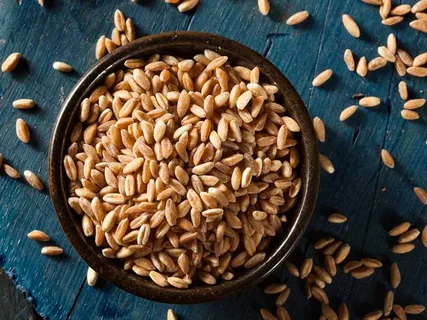5 Benefits of Farro, A Healthy and Nutritious Ancient Grain
Introduction
Farro, an ancient grain with roots dating back to ancient Egypt, has regained popularity in recent years due to its numerous health benefits and versatility in cooking. This comprehensive guide aims to delve into the nutritional profile of farro, its potential health advantages, culinary uses, and practical tips for incorporating it into your diet.
Nutritional Powerhouse
Rich in Nutrients
Farro is packed with essential nutrients, including fiber, protein, complex carbohydrates, vitamins (such as B vitamins), minerals (such as iron, magnesium, and zinc), and antioxidants. This nutrient density makes it a valuable addition to any diet, providing a wide array of health benefits.
Heart Health Promotion
Heart-Healthy Fibers
Farro contains a significant amount of dietary fiber, including both soluble and insoluble fibers. These fibers help reduce cholesterol levels, regulate blood sugar levels, improve digestion, and promote cardiovascular health. Regular consumption of farro may lower the risk of heart disease and stroke.
Blood Sugar Regulation
Low Glycemic Index
Farro has a low glycemic index, meaning it causes a gradual and steady increase in blood sugar levels compared to high-glycemic foods. This property makes it an excellent choice for individuals with diabetes or those looking to manage their blood sugar levels more effectively.
Digestive Health Support
Gut-Friendly Fibers
The fiber content in farro promotes digestive health by preventing constipation, supporting regular bowel movements, and nourishing beneficial gut bacteria. Including farro in your diet can contribute to a healthy digestive system and reduce the risk of digestive disorders.
Satiety and Weight Management
Satiating Properties
Farro’s high fiber and protein content contribute to increased satiety, helping you feel fuller for longer after meals. This satiating effect can aid in weight management by reducing overall calorie intake and preventing overeating.
Culinary Uses and Tips
Cooking Methods
Farro can be cooked using various methods, including boiling, simmering, steaming, and pressure cooking. It has a nutty flavor and a chewy texture, making it a versatile ingredient in a wide range of dishes, including salads, soups, stews, pilafs, risottos, and even breakfast bowls.
Flavor Enhancements
To enhance the flavor of farro-based dishes, consider cooking it in broth or flavored liquids instead of water. You can also add herbs, spices, vegetables, nuts, seeds, dried fruits, and cheese for added texture, flavor, and nutritional value.
Storage Tips
Store farro in an airtight container in a cool, dry place, away from direct sunlight. Proper storage helps preserve its freshness and prevents it from becoming rancid.
FAQs
Is farro gluten-free?
Farro contains gluten and is not suitable for individuals with gluten sensitivity or celiac disease. However, some varieties of farro, such as einkorn, are lower in gluten compared to modern wheat varieties.
Can farro be included in a vegan or vegetarian diet?
Yes, farro is plant-based and suitable for both vegan and vegetarian diets. It serves as an excellent source of protein, fiber, and essential nutrients in plant-based meals.
How does farro compare to other grains like quinoa and brown rice?
Farro offers similar health benefits to other whole grains like quinoa and brown rice. However, it has a distinct nutty flavor and chewy texture, adding variety to grain-based dishes.
Is farro easy to digest?
Farro’s high fiber content may initially cause mild digestive discomfort in some individuals, particularly if they are not accustomed to consuming fiber-rich foods. Gradually increasing intake and drinking plenty of water can help mitigate digestive issues.
Can farro be consumed raw?
Raw farro is not recommended for consumption due to its hard texture and difficult digestibility. It is best to cook farro before eating to improve its taste and digestibility.
Can farro help with weight loss?
Farro’s high fiber and protein content contribute to increased satiety and reduced calorie intake, making it a beneficial addition to a weight loss diet when consumed as part of a balanced meal plan.
Is farro suitable for individuals with diabetes?
Farro’s low glycemic index and high fiber content make it a suitable option for individuals with diabetes, as it helps regulate blood sugar levels and prevents rapid spikes in glucose.
Conclusion
Farro, with its rich nutritional profile, health benefits, and culinary versatility, is a valuable addition to any diet. Whether you’re looking to support heart health, regulate blood sugar levels, improve digestion, manage weight, or simply add variety to your meals, farro offers a multitude of advantages. By incorporating this ancient grain into your diet through creative cooking methods and flavor enhancements, you can enjoy its delicious taste and reap its numerous health benefits for years to come.
- Thc Infused Seltzers In Utah UT - May 30, 2025
- Skin Pen Microneedling Near East Clandon, Surrey - May 30, 2025
- Skin Treatment & Skincare Consultations Near Ewell, Surrey - May 30, 2025

